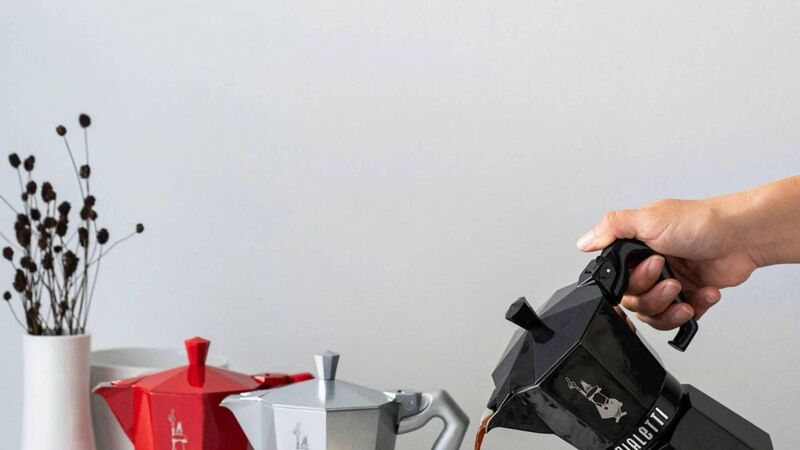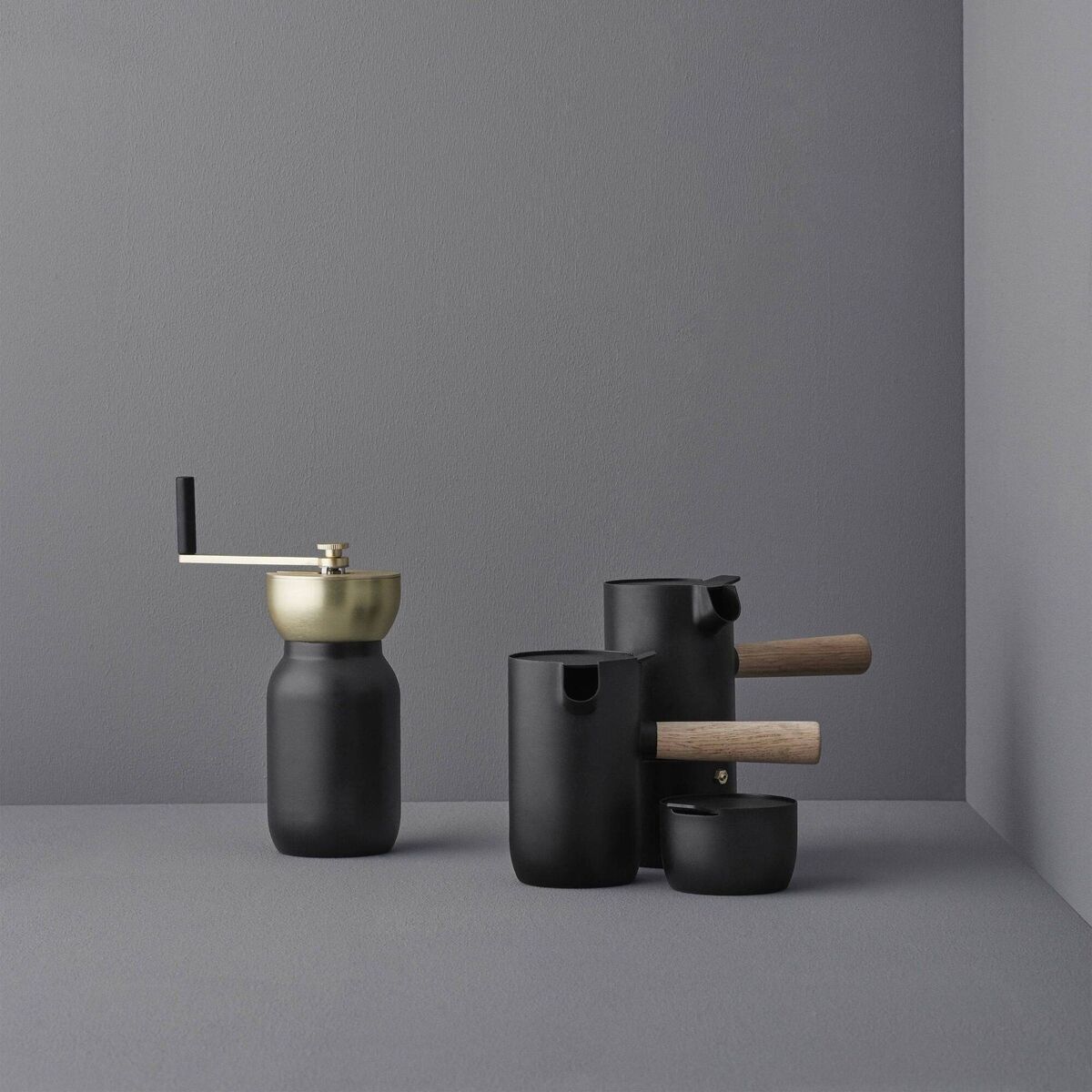Why moka pots are brewing up a storm in nostalgia coffee-making

Bialetti Express six-cup, from €33 depending on edition.
My daughter and her 20-something friends are all buying moka pots. I was curious. A tiny manual espresso maker forcing water through a bed of pricey ground beans? It’s not the swiftest way to make the slimy oat milk coffees they all seem to love. A moka requires turning on a stovetop — not something common to exhausted post-grads with part-time jobs. Once you’ve wrangled the pot and its antique demands, you then need to deal with any hot milk additions separately.
Dashing through life waving a Leap card, it seems a torturous choice for a morning brew. Still, the first time I watched unseen as my chick conjured coffee with her tiny red Bialetti, I realised what it is that’s nurturing this social-media trend. It’s the quiet ritual, the hands-on intentional steps, the intimate mechanics of engaging with the coffee grounds. All that measuring, eyeballing the fill, burnishing the protected and special coffee spoon, and replacing the hefty, handsome little pot on the shelf.
With few moving parts and no lead required, moka pots are an affordable choice in nostalgia coffee-making, and they deliver a more flavoursome punch for the same price as a drip machine.
Simple to use and diminutive enough to travel in a roomy carry-on, moka pots are often a cherished personal object that travels through life with the owner. I’ve had the same vintage Bialetti pot for 40 years, replacing just the rubber gaskets (available online) and taping up the Bakelite handle after the pot went airborne and hit the tiles. My pot was already dulled by use when I got it from Barnardos for 50p as a kid. That’s part of its dinged-up charm. It’s weirdly comforting to know it’s older than I am.
Moka pots are not simply a TikTok pretension; they are a cherished staple in every Italian kitchen and ancient music to many of us who have fond memories of balancing our art deco pot on campsite flames and staggering over to wrestle the Bialetti apart for a morning cuppa in a mangy bedsit. A small percolator, mokas require just a few meditative minutes to extract a deep, dark, rich brew under just 1.5bar of pressure — and they remain surprisingly cheap. The ideal ratio of coffee to water is around 1:10, but finding your sweet spot is part of the magic, and this could be as pulse-raising as 1:7 if you’re brave.
If you’re tuned into contemporary coffee life, you will know that proper espresso (made since the 1880s) is the base of just about every high-street flat-white and Americano in a single or a double dose. A moka pot, despite some having what’s termed a crema valve, is not strictly speaking an espresso maker. It doesn’t offer enough bar pressure, and the percentage of tiny coffee grounds left in the cup is too low.
Once working, you cannot just leave a moka pot to do its thing like you can a filter coffee maker or smart, pod machine. You have to watch out for the burble. If the base runs dry, steam coming through the funnel can ruin the brew. The nerdy name for this is a Strombolian phase, and with light, highly conductive stainless steel mokas, it can happen two or three minutes after you put the pot on the heat. If you want a real espresso maker to automate a genuine espresso, buy an electric machine.
Choosing your own moka pot, the first stop (and I would argue the last stop) is the original polygonal Bialetti Moka Express, in sturdy, highly insulating aluminium, made in Italy. Priced from €33 for a 6-cup depending on the edition, the Bialetti Moka was first produced in 1933 in a foundry in Conchiglie, Italy. Designed by Alfonso Bialetti, this is an icon celebrated in design museums across the World and was named for the cradle of coffee growing — Mokha in Yemen. It comes in three parts, like every manual moka pot today. There’s a nice, fat-bottomed base for the water, a filter funnel and grounds basket, and a top section where the coffee appears. Coffee gradually bloops up under vapour pressure through a metal spout crowned by a crema valve if you choose a Bialetti Brikka. The Bialetti Moka Express remains popular due to its generous coffee basket, which allows for the perfect ratio of coffee to water without tamping (outlawed with moka pots). A little hack — some moka users use an additional filter in the basket for a cleaner cup of coffee (Aeropress filters are popular).
The Bialetti comes in a range of sizes determined by the number of demitasse cups of 40ml-60ml, and of course, that can be counted out in mug sizes of 200ml plus. The only drawback with aluminium is that it doesn’t do well in the dishwasher, and it’s not just the damage to the pot; it’s the tiny levels of aluminium that can be released in the process. Always tenderly hand-wash your manual Bialetti in very hot water for everyday cleans and never use acidic de-scalers on it. Leave it to air dry before putting it back together. Eventually, you will have to take a mild detergent to the coffee oils and residue, but rinse it repeatedly to avoid tainting the metal.

Pure aluminium pots (every vintage one you’ll find) are unsuited to induction stove-tops without slipping in a dedicated steel adapter (Bialetti €25). Otherwise, you’ll need a stainless steel moka pot or a twin-material type. The sleek, Bialetti Venus is gorgeous in steel with a copper top section (€44.90 — best price directly from Bialetti). I haven’t tried this or the new Musa out yet, but I have to. The reviews for these more lightly constructed pots are mixed.
Some coffee romancers are reporting issues with build quality, fiddly cleaning, poor flavour, and an acidic aftertaste in the coffee. Try to borrow one before you jump. Otherwise, explore the Bialetti Moka Induction line from €42 for a six-cup, and limited-edition colours in original heavy gauge aluminium fitted with an integral steel base to ride on induction hobs from €70.
There are so many pretty varieties of moka pots out there; it’s important to remember that they not only have to be disassembled before and after use, but also have to sit over a heat source. Try to get your hands on the model you’re considering. Is it aluminium or stainless steel? Is it suited to induction stove-tops? Does it screw apart with liquid ease for loading and cleaning?
How wide and stable is the base? Is the basket deep enough to take sufficient coffee without tamping? Does it appear to have good build quality? Run your fingers over the pot to discover any jagged edges. A heat-resistant handle is a nice touch when you’re picking up a relatively small pot centred on a larger stove ring.
My experience with my moka pot? Choose an aluminium pot and really good coffee grounds, a coarser grade than espresso, and avoid tangy, metallic, city water. Cheap blends don’t make tasty coffee in a basic little coffee maker. Finding the right grind can be tricky, as pre-ground espresso can be too powdery.
For the best aroma and flavour every time? Use local, artisan brand ground coffee from a sealed bag, or invest in a coffee grinder. Burr machines are the most expensive (said to be transformative), but you can find a reasonable bladed machine for around €70. If the moka pot is left assembled for hours after use, it will become chronically damp and dirty, delivering a horrible soup. Ensure you give it a thorough clean from time to time.





